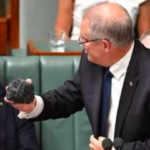The Budget’s Climate Denial: An Interview With Economics Professor John Quiggin

University of Queensland Professor John Quiggin is an economist, who’s had a focus on the environment that goes back years. A former member of the Climate Change Authority, the academic has written on policy topics that range from changing climate to the Murray-Darling river system.
So, given the recent budget was the first following a climate-driven bushfire crisis that destroyed 20 percent of mainland forest and was intensified by a water shortage crisis in the south east of the country, you’d expect the professor to be scoping the figures for a government response.
But, according to Professor Quiggin, the budget is just more of the same. He asserts that not only does it present as if the bushfire crisis never happened, but it also fails to adequately address the COVID-19 pandemic that continues.
The focus of the 2020 Budget on the surface is all about stimulating the economy at a time of deep recession. However, while the Morrison government rolled out JobMaker, it pulled back on JobKeeper and JobSeeker. And as it cut taxes, it did so for those who won’t use the funds.
The gas-led recovery
The government is investing $52.9 million in expanding the nation’s gas industry. The proposal to lift the economy out of the COVID downturn via a gas-driven recovery has slowly come to light over the last six months.
In late March, the PM established a corporate advisory body to help steer the economy through the pandemic. And documents emerged in late May that showed the National COVID-19 Commission Advisory Board (NCC) saw climate-destructive gas as the way forward.
Morrison officially announced the “gas-fired recovery” in mid-September. His regressive vision for the future includes opening up “five key gas basins” across the country and giving a firm prod to getting pipeline infrastructure underway.
The cover of COVID has allowed the Liberal Nationals government to continue with its fossil fuel agenda straight after the fallout from the bushfires, which is something that would have proven difficult if the killer virus and accompanying shutdown hadn’t provided distraction.
Further disappointments
The budget allocates funds for investment in renewable energy, as part of its wider lower emissions technology package that it announced last month. However, writing in the Conversation on 7 October, Professor Quiggin described the financial outlay for the next four years as “pretty paltry”.
The economics professor further pointed to the Morrison government’s plan to invest in the refurbishment of the Vales Point coal-fired power station, which just happens to be part owned by a prominent Liberal Party donor.
Sydney Criminal Lawyers spoke to Professor Quiggin about why the government’s attempt to address renewables doesn’t cut it, its decision to invest in carbon capture and storage technology, and the way that Australia could move forward without relying on fossil fuels.
Firstly, the recent budget had a focus on the JobMaker stimulus package, as well as the bringing forward of tax cuts. Overall, Professor Quiggin, what are your thoughts regarding the financial plan the Morrison government has delivered at this moment of deep recession?
The tax focus is on middle- and high-income earners, so that’s a misdirected stimulus. The people who get the tax cuts, by definition, are people who haven’t lost their jobs, and are likely to save rather than spend the proceeds.
The government is also setting a path that’s liable to lock in low revenue for a long time to come, even though we really need substantially increased public spending in a range of areas. So, that’s a major problem.
The JobMaker stimulus package has a lot of potential, as it focuses on a group that’s been heavily affected by the pandemic, but that’s really the exemption, rather than the rule.
Again, there’s a lot of emphasis on tradies and road projects, which are the kinds of things the government reflexively reaches for that aren’t really appropriate in the context of a pandemic.
Last summer, saw the worst bushfire season ever, which followed on the worst drought-water shortage crisis in living memory.
Would you say that the overall approach the budget takes to supplying energy in any way shows a response to the very real crises that have just occurred?
Not at all. If they brought the same budget down a year ago – before the bushfires and the pandemic – the policy elements would look much the same.
It’s entirely political symbolism without any focus on the real problems we face.
The government has allocated $52.9 million to expanding Australia’s gas industry. In your understanding, why is the government so focused on turning towards gas right now? And what are the implications of this new direction?
This is essentially symbolic. The government is lumbered with a large element of its backbench and its base, who are fervently in favour of fossil fuels, and pushing them hard on them.
They can see coal is obviously not a goer, so they have no political choice but to push gas. Whether this ever happens on the scale they’ve imagined remains to be seen.
In September, the government launched a new package to invest in lowering emission technologies. It includes $1.6 billion provided to ARENA (the Australian Renewable Energy Agency), which you claim is far less than what’s needed.
Why is this investment inadequate? And why doesn’t it mark a shift in the government’s position on clean energy?
They’ve shifted their definition so as to treat solar and wind as mature technologies that don’t need support. There are some pointed elements in terms of transmission and limited support for batteries and other things.
But really what we see is the government allocating funds based on symbolism rather than any coherent idea of what we need to meet our targets, and in particular, what we committed to in Paris, which isn’t merely a 2030 target to be shuffled through accounting, but an actual program to decarbonise the economy by 2050.
There’s just no sign of that in the budget. So, it’s really a matter of picking bits and pieces that seem politically appealing, rather than any kind of coherent strategy.
As part of its emissions package, the government is investing $50 million in carbon capture and storage (CCS) technology. You describe this as “simply laughable”, why is that the case?
It’s important to know that this is in the context of what the government has described as a “stretch goal” of reducing CCS to $20 a tonne, which would make it viable technology.
Now, Australia alone spent $500 million on this between 2006 and 2014 as part of the Coal21 program, and we saw nothing for that. Canada has put a lot of money into pilot plants, and so has the US.
The idea that billions of dollars spent around the world has had no effect, and somehow $50 million allocated by the Australian government is going to significantly change the economics of CCS is, as I said, laughable.
You also note that the government is investing in the refurbishment of a NSW coal-fired power station part owned by a big Liberal donor.
So, taking all of this together, how does the Morrison government’s financial planning on energy place our nation on the global stage?
I should mention that the coal investment is a relatively small amount but improper in every way.
Assuming that we see a Biden victory in the November election, Australia will be right at the back of the developed world – of all the countries in the world, really.
China has committed to a 2050 target for decarbonisation. So, we’ll find ourselves with Saudi Arabia at the very back of the pack.
And lastly, Professor Quiggin, you’re an economist with a long involvement in the environmental movement. In your understanding, how should Australia be investing at a moment when the planet is facing ecological and climate collapse?
We should be investing on a large-scale in renewables. And looking not merely at decarbonising our own economy, but becoming an exporter of renewable energy, either for electricity through high voltage direct current cables to our region, or through green hydrogen.
Again, the government has shuffled on this. They have talked about hydrogen, but they still have an imaginary idea that we’ll have a CGS technology that will make hydrogen green, even though it’s derived from lignite.
If we could get rid of that fantasy, and produce hydrogen using renewably generated electricity, and then export our electricity either directly through cables or in the form of hydrogen, that’s the approach we need to be taking.








